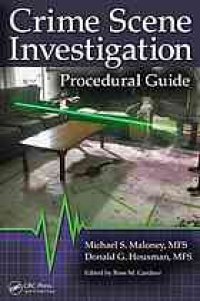"Specifically written for field use, this book provides a concise, ready source of information for the processing of the most commonly encountered crime scenes involving both persons and property. The book begins with the initial response and continues on to cover evidence documentation, processing, preservation, and collection. All aspects of scene procedure are covered to make sure investigators don't miss
valuable clues that could make or break a case. The book includes a CD-ROM with downloadable forms needed for crime scene investigations"--"Preface This book is meant to be used at the scene, as a practical field guide when responding to the scene of a crime. Some information in the various chapters of the guide may seem repetitious; this is meant to facilitate its field use by minimizing the need to flip back and forth while processing the scene. The guide is separated into the following sections for ease of use, with primary processing accomplished through Section I Section I, "Crime Scene Investigation," includes initial response, crime scene organization and management, crime scene tasks and responsibilities, as well as search methods. Section II, "Crimes against Property," covers a protocol for their processing as well as the various types of evidence they might present. Section III, "Crimes against Persons," details a protocol for their processing as well as the various types of evidence they might present. Section IV, "Evidence Processing and Documentation," is used to supplement crime scene investigation by providing detailed steps to refresh the crime scene investigator's (CSI) memory on friction ridge, trace, impression, biological, bloodstain, and shooting scene evidence processing and documentation. The appendixes contain a variety of reproducible, easy-to-use worksheets to help organize documentation and notes while at the scene"--
�Read more... 